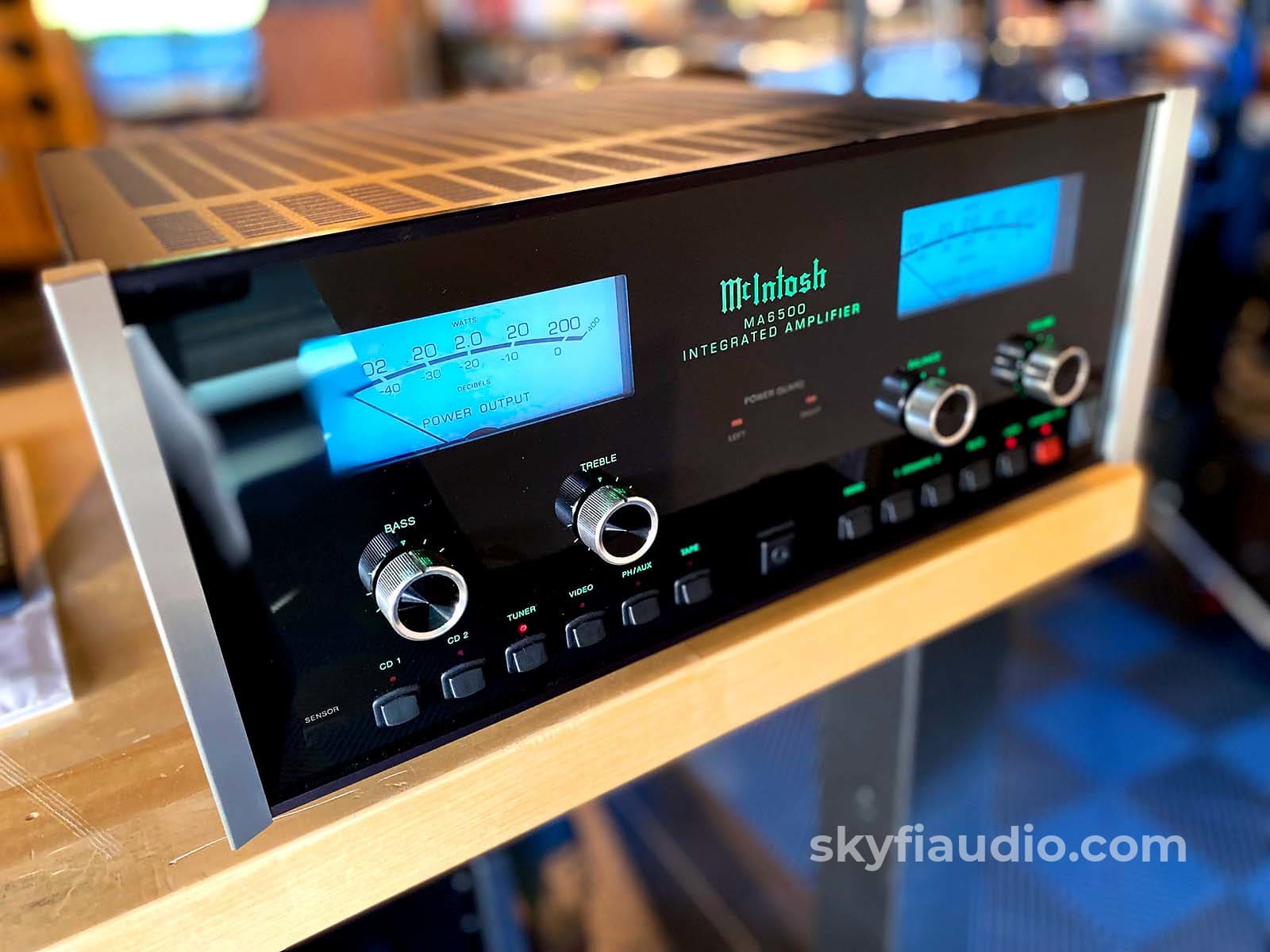
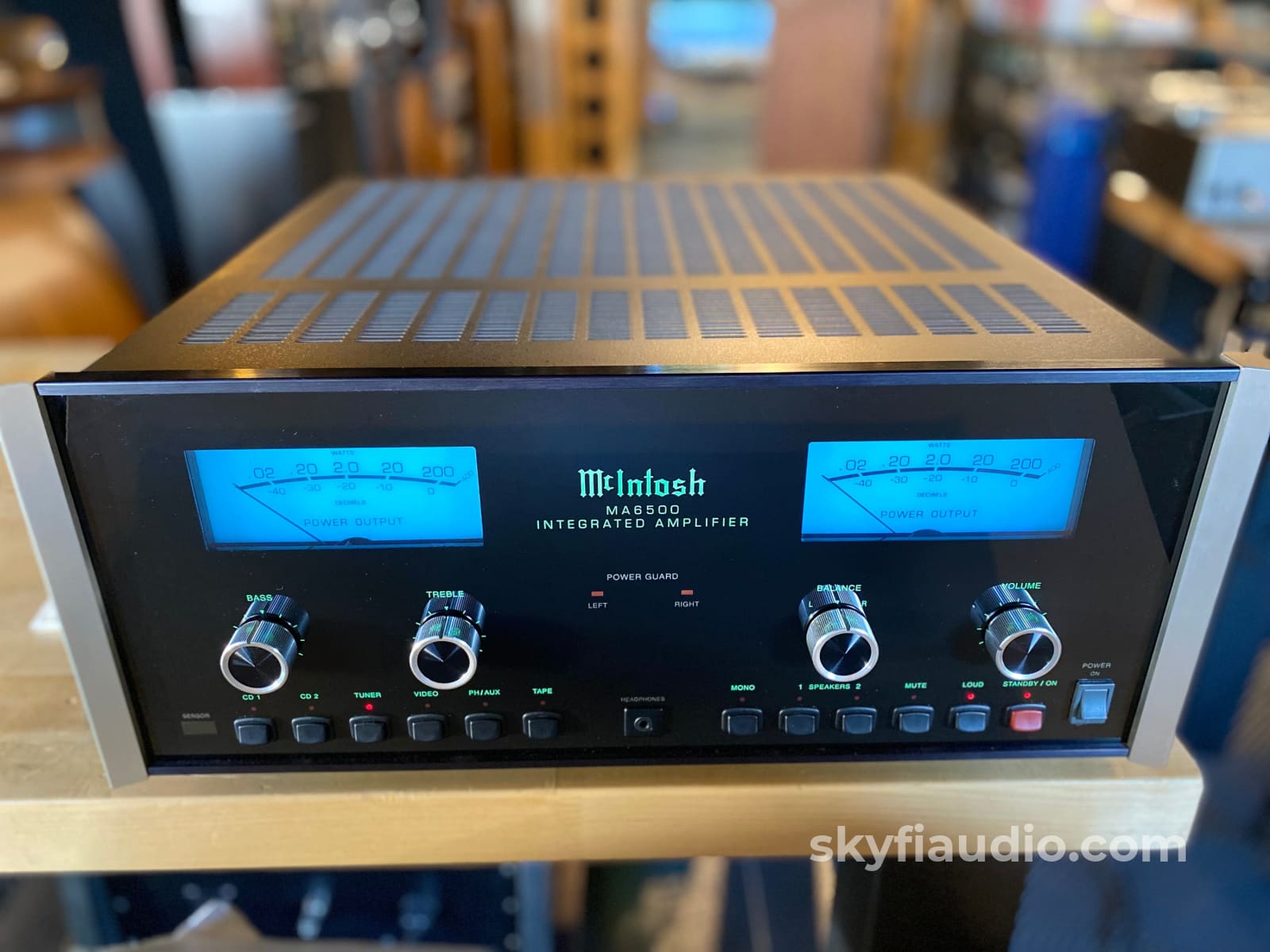
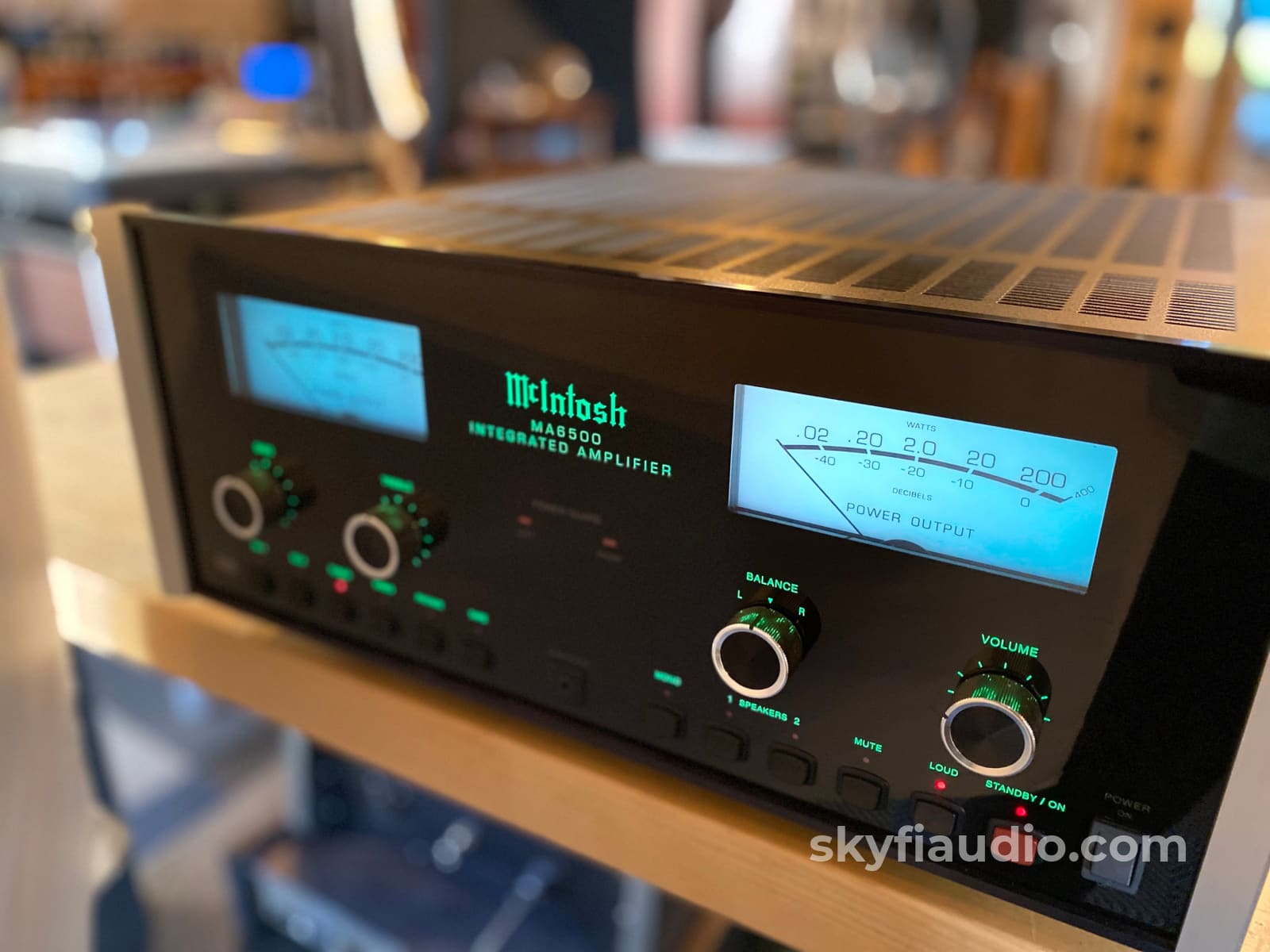
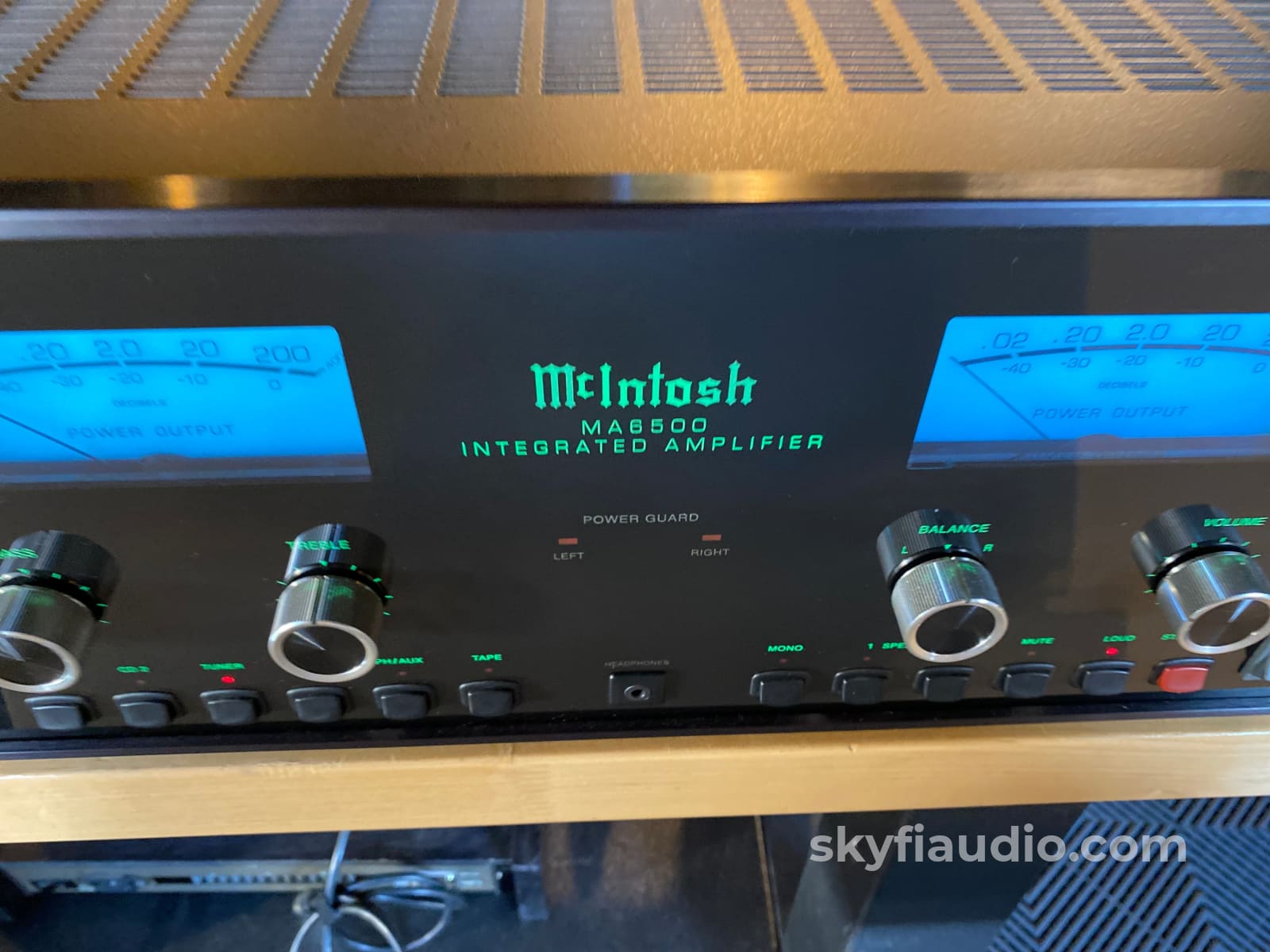
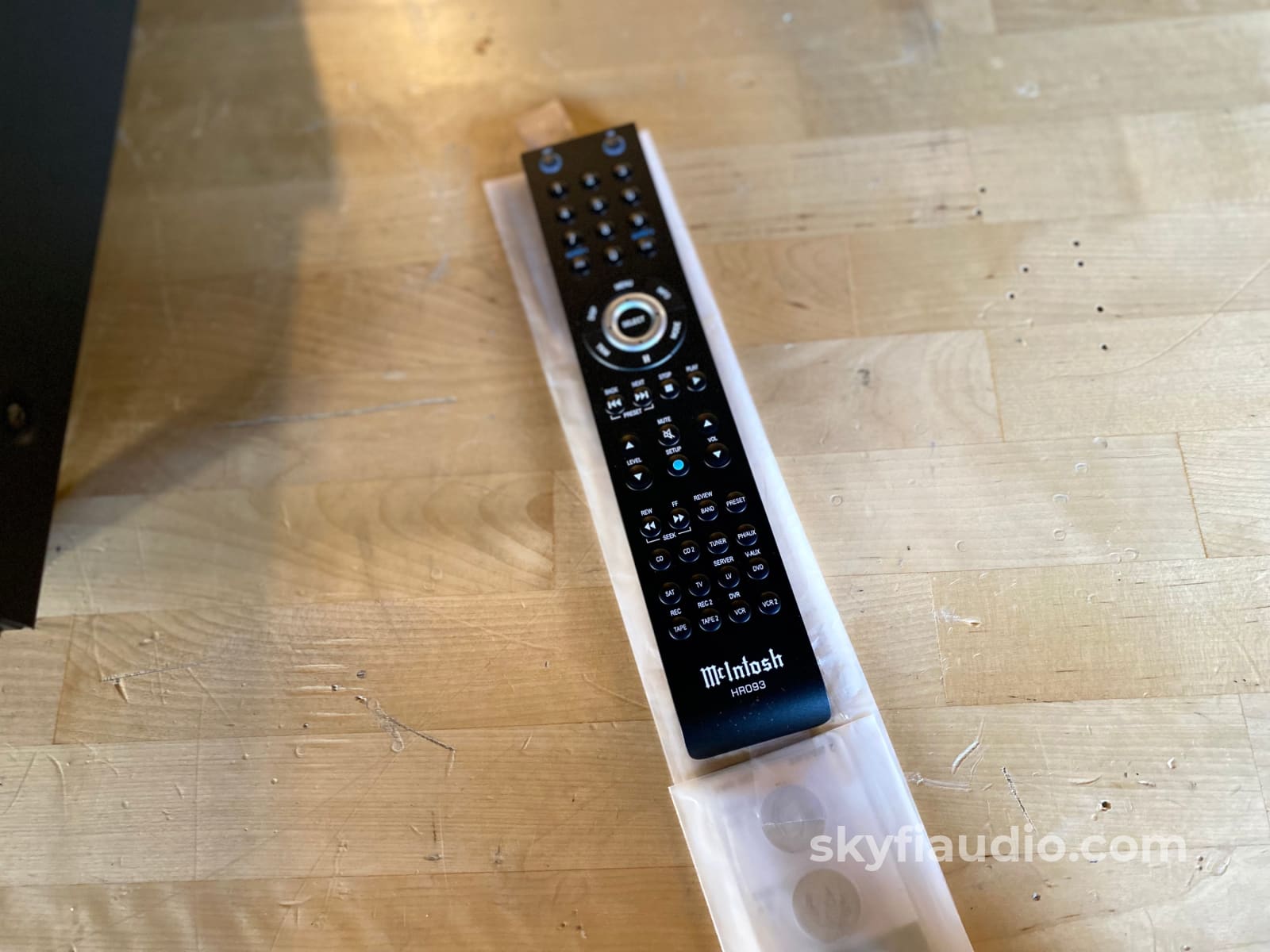
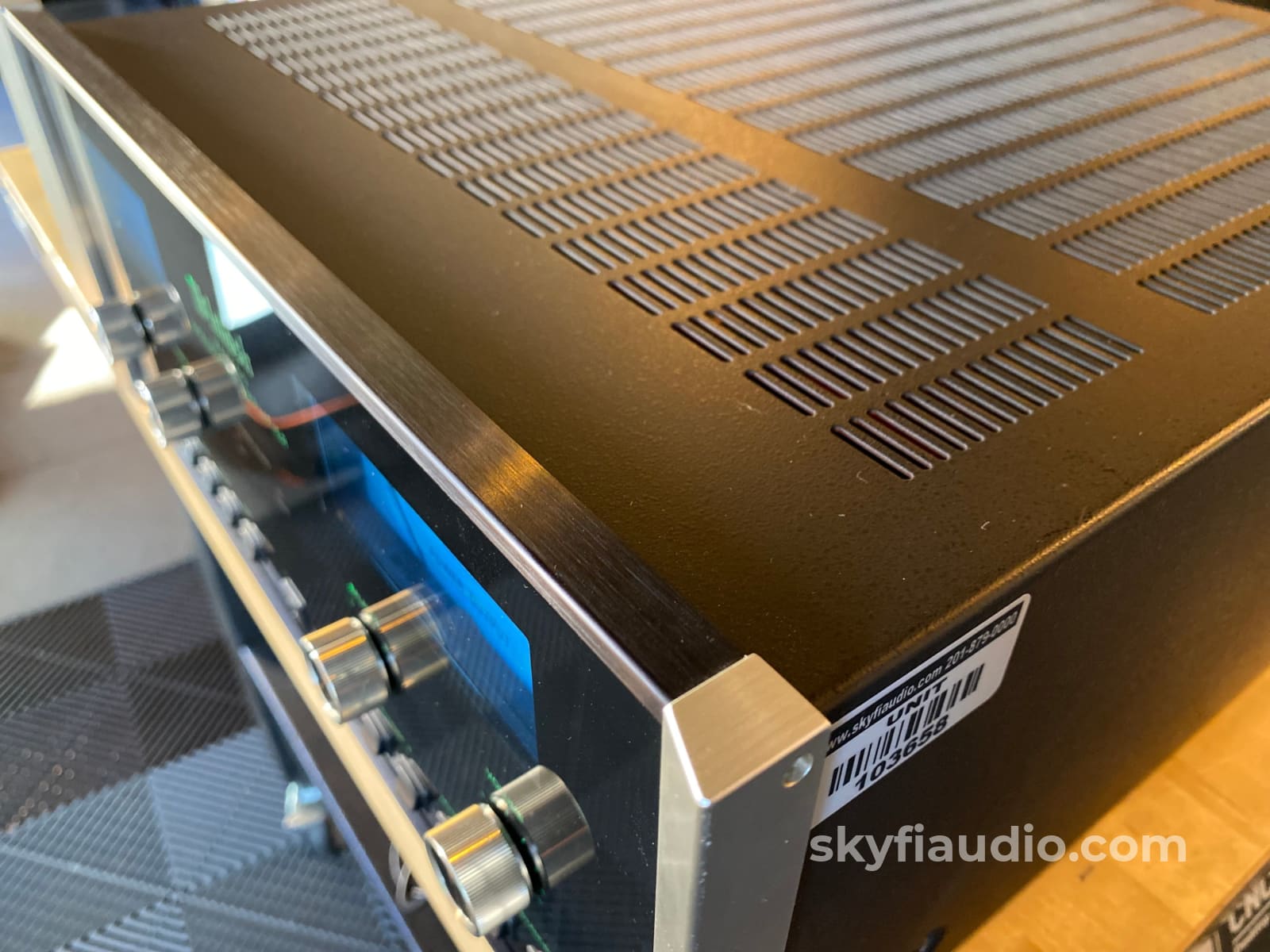
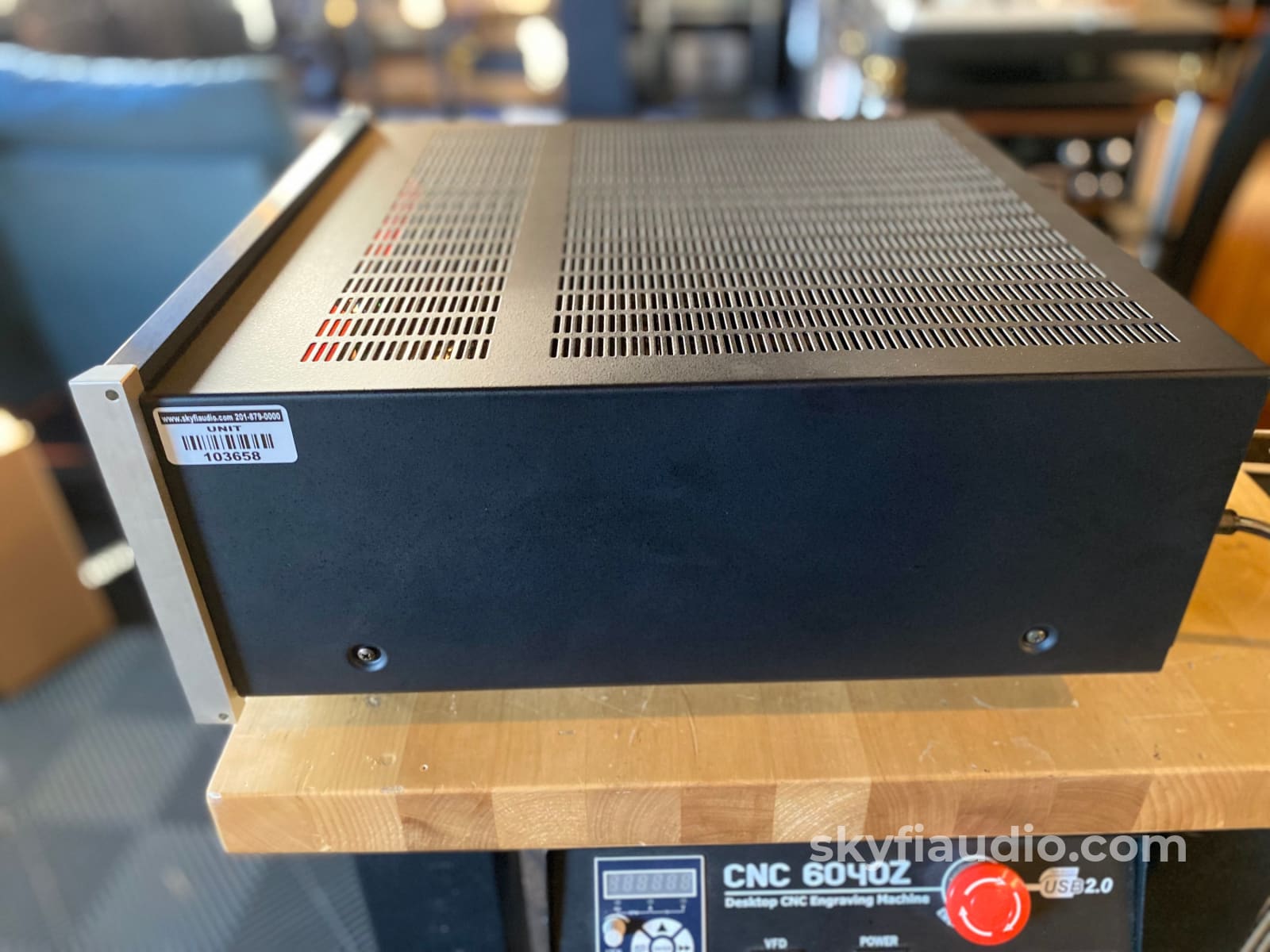
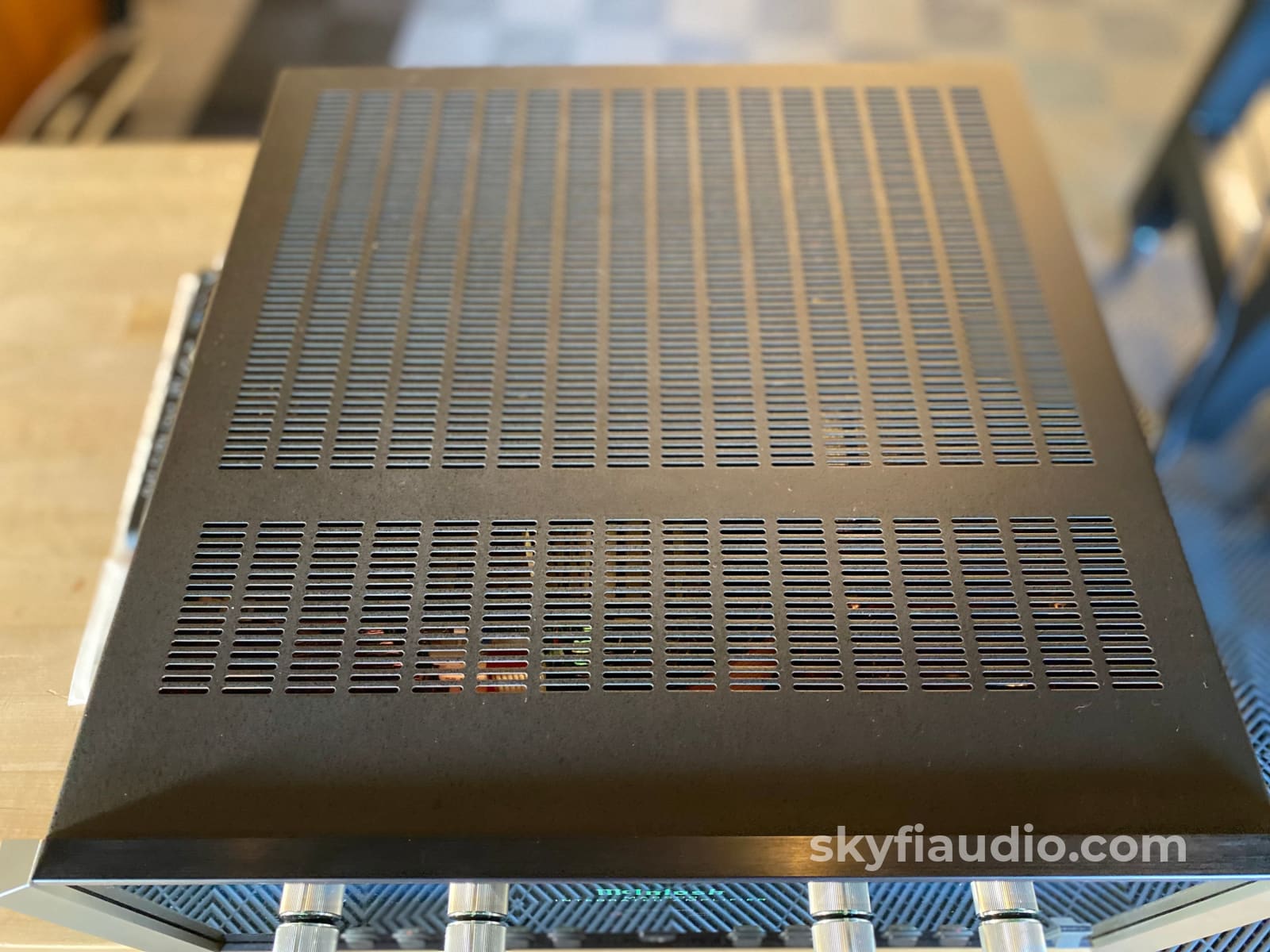
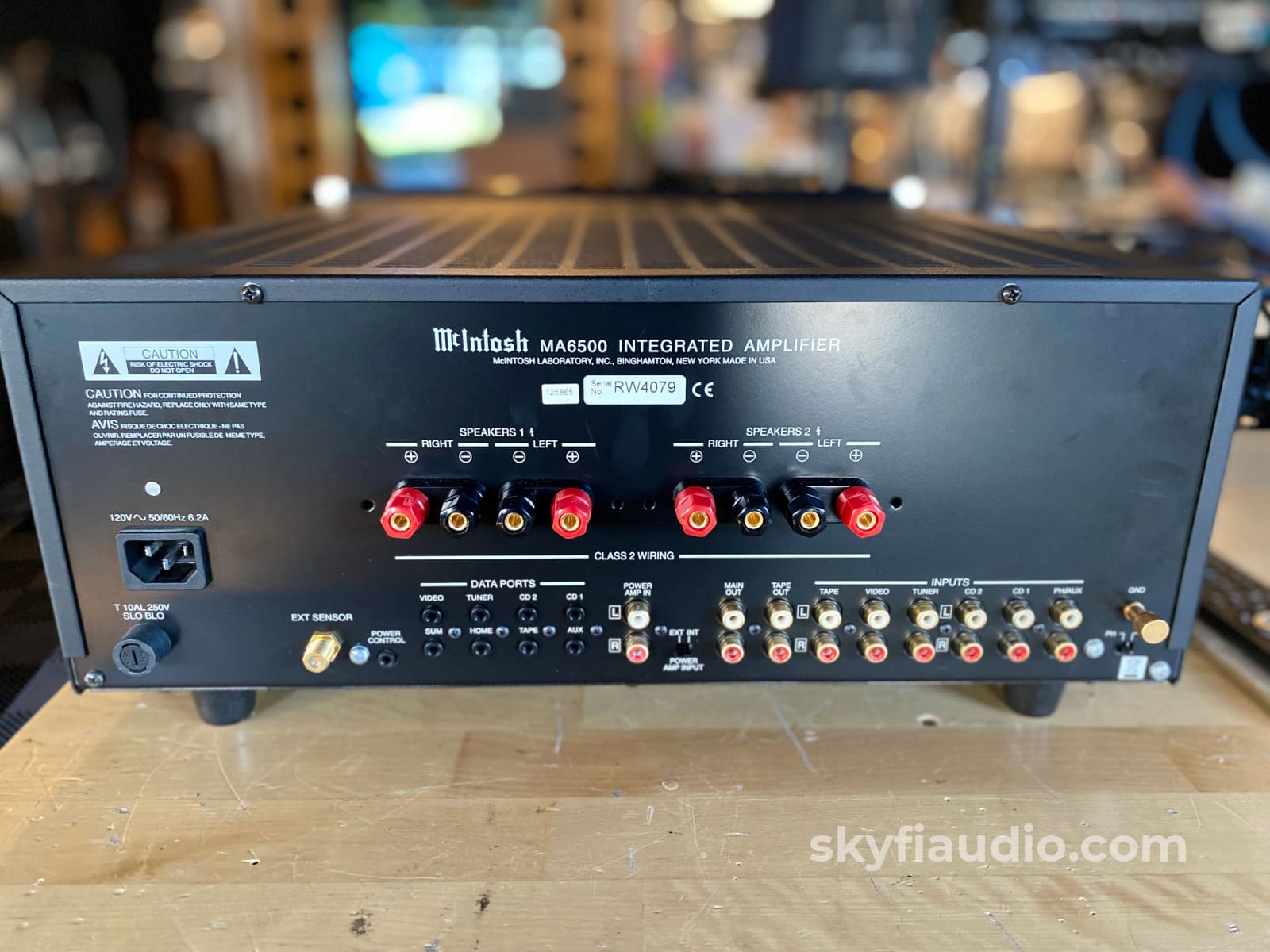
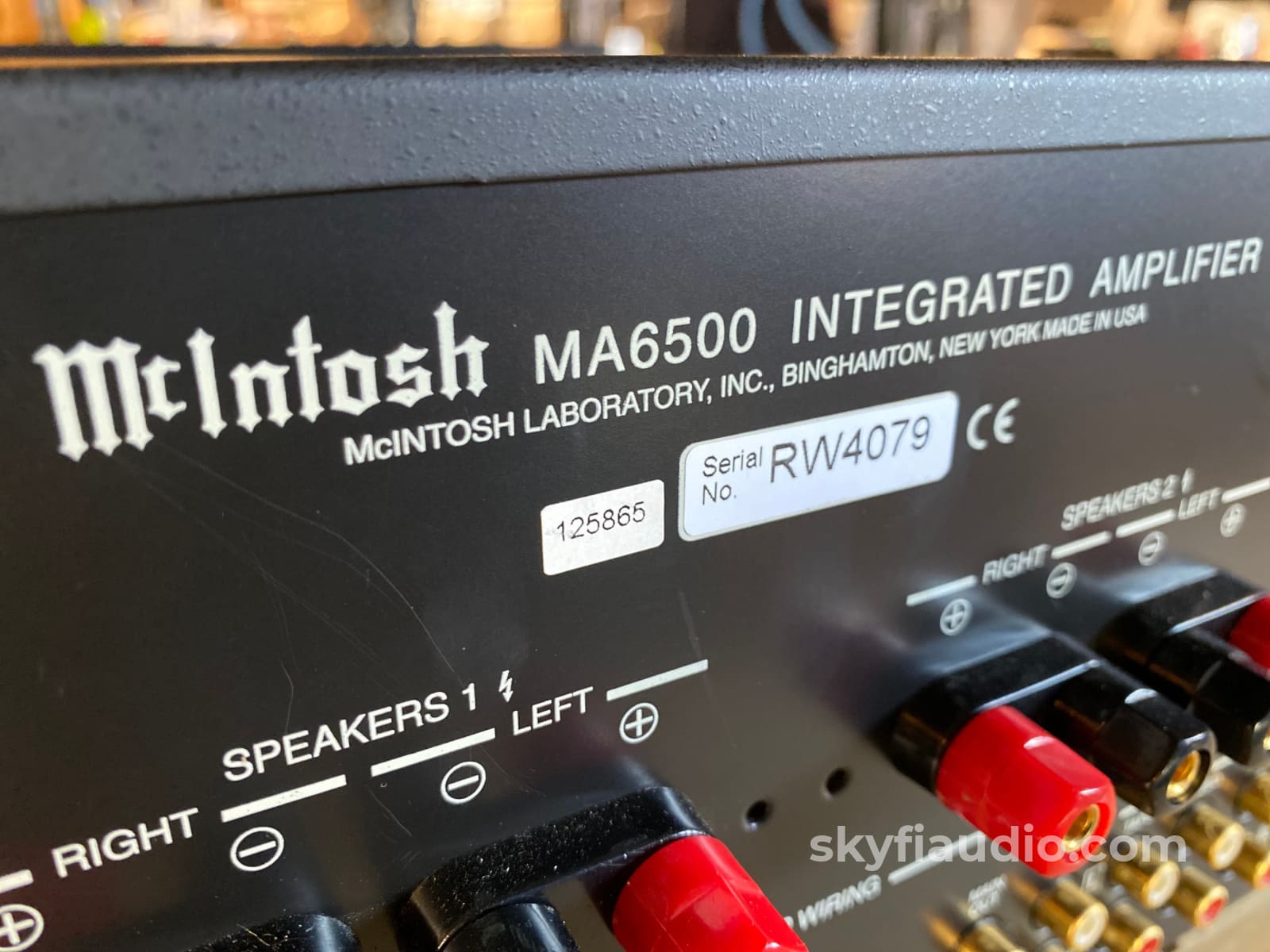
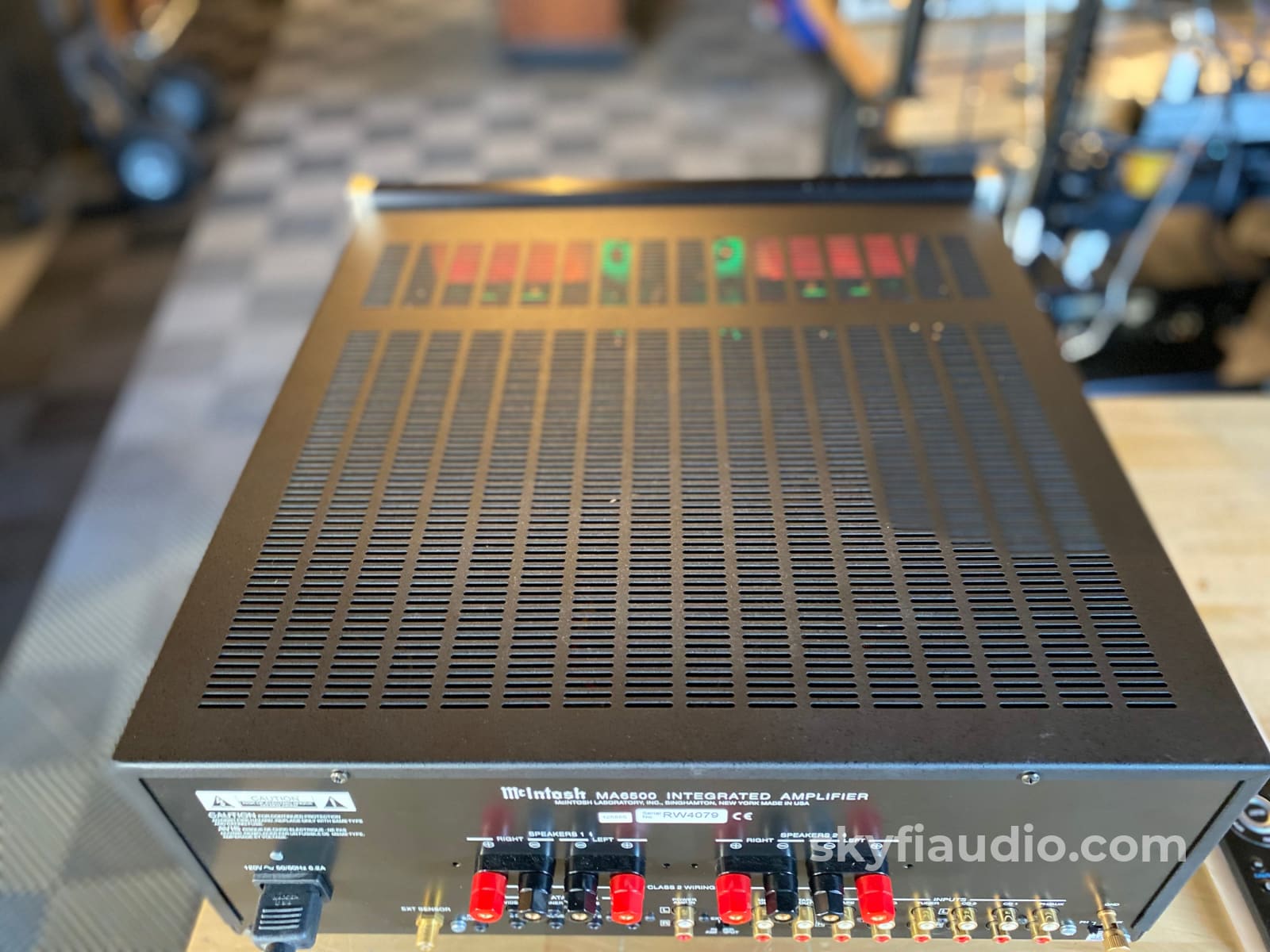

McIntosh MA6500 Integrated Amplifier - All Analog
Free Shipping on Most Electronics - Excludes Speakers and Items Requiring Freight - Contiguous U.S. Only
Pickup currently unavailable at SkyFi 479

McIntosh MA6500 Integrated Amplifier - All Analog
SkyFi 479
479 South Broad Street
Glen Rock NJ 07452
United States
General:
Recently McIntosh started building DAC's into almost every integrated. If you're a purist you're going to want an integrated that's just that, minus the bells and whistles.
This model from the last decade is a solid performer, and a great way to get some McIntosh magic into your system.
At 200W per side, its plenty of power to drive most speakers, even the more difficult ones.
McIntosh Performance Features Include:
• Power Output
Two separate power amplifier channels, each capable of 200 watts and a sophisticated control center in one compact unit with less than 0.005% distortion.
• Power Guard
Both channels include the patented McIntosh Power Guard circuit that prevents the amplifier from being overdriven into clipping with its harsh distorted sound that can also damage your valuable loudspeakers.
• Electronic Input Switching
Digital Logic integrated circuits drive Electromagnetic switches on all six inputs and operating functions for reliable, noiseless, distortion free switching.
Brand background:
McIntosh Laboratory is an American manufacturer of handcrafted high-end audio equipment based in Binghamton, New York. The company was founded in 1949 by Frank McIntosh. The company designs and produces audio amplifiers, stereo tuners and other consumer electronics products.
McIntosh is known for offering distinguished home audio systems that deliver the ultimate experience in music and film. Offering products for two-channel stereo sound systems and multi-channel home theaters with surround sound, McIntosh continues to define the ultimate home audio entertainment experience for discriminating listeners around the world. Our iconic blue Watt output meter is globally recognized as a symbol of quality home audio. With a McIntosh home stereo system or home theater, listeners have the ability to create their own luxury audio experience – and truly live their music.
Ownership:
One single owner since new.
Connections:
6 single-ended RCA inputs including one phono. Two sets of speaker binding posts for bi-wire capability. Removable power cord.
General sound:
Warm sound with great harmonics and laid back delivery, just what you would expect from a McIntosh.
Cosmetic condition:
We rated this a 7 with light signs of use and wear. See our detailed rating description by clicking here.
Working condition, Technical Notes:
Working properly, fully tested in our lab and listening room. Lightly serviced, cleaned all controls, changed all bulbs, internal and VU meter cleaning.
Included:
MA6500 as described and pictured, power cable, and a brand new factory fresh McIntosh remote.
Packing:
Will be packed in a new McIntosh double box ensuring safe transit for the glass faceplate.
Original MSRP:
$4500
Specs:
RMS Power Output (8/4/2 ohms)
120/200/250W min. sine wave continuous average power output per channel from 20Hz to 20kHz with both channels operating
Output Load Impedance
2, 4, or 8 ohms
Rated Power Band
20Hz to 20kHz
Total Harmonic Distortion
0.005% max. at any level from 250 milliwatts to rated power per channel from 20Hz to 20kHz with all channels operating
Intermodulation Distortion
0.005% max. if instantaneous peak power output does not exceed 400W per channel
S/N Ratio (A-Weighted)
Power amp: 110dB below rated output
High level: 100dB below rated output (90dB IHF)
Phono: 90dB below 10mV input (84dB IHF)
Damping Factor
230 (8 ohms) 120 (4 ohms) 60 (2 ohms)
Input Impedance
High level: 22k ohms Phono: 47k ohms, 65pf Main in: 20k ohms
Voltage Gain
High level to tape: 0dB High level to main: 20dB
Dynamic Headroom
2.4dB
Frequency Response
20Hz to 20kHz, +0 / -0.5dB
Maximum Voltage Output
8V from 20Hz to 20kHz
Input Sensitivity
High level: 250mV for 2.5V rated output (50mV IHF)
Phono: 2.5mV for 2.5V rated output (0.5mV IHF)
Main in: 2.5V for rated output
Maximum Input Signal
High level: 10V Phono: 90mV
Power Guard®
Clipping is prevented and THD does not exceed 2% with up to 14dB overdrive at 1kHz
Tone Controls
Bass and treble: ±12dB
Weight
41 lbs. (18.6kg) net
60 lbs. (27.3kg) shipping
Dimensions
inch: 5.375 x 17.5 x 18.125
cm: 13.7 x 44.5 x 46
Age:
Unit was built in the early 2000's.
Reviews:
N/A
Link to manual:
Click Here
Recommended Cables:
Kimber Kable - RCA Interconnects - Better
Kimber Kable - RCA Interconnects - Best
Kimber Kable - Speaker Cables - Good
Kimber Kable - Speaker Cables - Better
Kimber Kable - Bi-Wire Speaker Cables - Best
Kimber Kable - Power Cords - Good
Kimber Kable - Power Cords - Better
Kimber Kable - 14AWG (Gauge) Power Cords - Best
The SkyFi Testing Process for Preamplifiers:
We start with a visual inspection of all internal components to make sure that there are no signs of heat stress or damage. Capacitors are checked for telltale signs of predictive failure including bulging, shrunken wrappers, or physical leakage. We also inspect the PCBs for discoloration from resistors or transistors that may have been running hot. On vintage units we often spot check select capacitors for value and ESR.
When we first power on a preamplifier we connect its RCA output to a Sencore PA81 Power Analyzer which simulates real world loading conditions and gives us an oscilloscope interface. The first order of business is checking that the volume control works smoothly throughout its entire range with acceptable channel balance. This is accomplished by feeding a 1KHz sine wave into one of the preamp’s line level inputs while monitoring the preamp’s output on an oscilloscope. We then switch to a 1KHz square wave to test the tone controls, loudness function, and filters where applicable. During this step we are watching for equal alteration of the test signal by both channels. This also helps us identify dirty controls that will need treatment. Once the basic line stage functions are verified, we test each input individually. This is especially important for devices that use relays to select their sources. If the preamp is equipped with a phono stage we test that as well. We use an inverse RIAA filter which allows us to feed a reference test signal into the phono input with the proper RIAA equalization and level. A square wave or sine sweep is used to verify that the device’s phono stage is faithfully reproducing the RIAA curve. If the preamp under test has balanced inputs and/or outputs these are tested as well.
We finish up our bench testing with a listening test with our bench amplifier and reference speakers. During this test we check for hum or hiss that may not have shown up in earlier testing. We also check that all of the tone controls and filters perform as expected. If the preamplifier has remote control functions these are also tested. Preamps with tube circuits or complicated power supply topologies are connected at our long term test rig for extended stress testing under real world conditions.
The SkyFi Testing Process for Solid State Amplifiers:
We start with a visual inspection of all internal components to make sure that there are no signs of heat stress or damage. Capacitors are checked for telltale signs of predictive failure including bulging, shrunken wrappers, or physical leakage. We also inspect the PCBs for discoloration from resistors or transistors that may have been running hot. On vintage units we often spot check select capacitors for value and ESR.
If the amplifier passes visual inspection, we move on to a controlled power on sequence using a Sencore safety analyzer to monitor current draw in real time. Once the amplifier is determined to be safe to operate, we connect it to full AC mains for function and power testing. We connect the speaker outputs of the amplifier to a Sencore PA81 Power Analyzer which acts as a dummy load, DC offset monitor, and oscilloscope interface. We start with a low level 1KHz test signal at the amplifier’s input and slowly increase its amplitude while monitoring the output on an oscilloscope for signs of noise, clipping, distortion, or improper channel balance. We continue increasing the signal level until the amplifier reaches clipping. At this point we take an output power measurement and compare it to the spec sheet of the amplifier to verify proper performance. If the device under test has both balanced and single ended inputs they are both tested at this time. We finish off the bench evaluation with a 1KHz square wave check and a 20Hz to 20KHz sine sweep to assess the amplifier’s frequency response characteristics. This battery of tests will usually reveal if the amplifier has any issues that need further attention.
Before the device leaves the bench, we perform a listening test with actual music using a variety of preferred test tracks. Our benches are outfitted with familiar monitor speakers which help us identify inconsistencies that will not always show up on our test gear. The main things that we are listening for are hum or noise with no signal present, proper center image, clicks, pops, or any other obvious undesirable audio characteristics.
If the unit passes all of these tests it is moved to our long term testing rig where we simulate real word operating conditions for 6-8 hours. This allows us to monitor the unit for signs of thermal runaway or intermittent issues that only crop up when the unit has fully come up to temperature.
|
Item |
Included |
|
McIntosh Box |
Yes |
|
Manual |
Not Included (Online) |
|
Remote |
Yes - New |
|
Cables |
Yes - Power Only |
|
Physical Condition (Info Here) |
7 / 10 |
|
Working Condition |
10 / 10 |
Choose options












